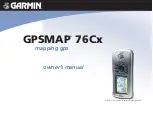
SPIDAR Software
30
Based on the positions listed, the Noggin 1000 would be at the front centered on the origin (0,0),
and the Noggin 500 behind it.
NIC-500N
– Multiple NIC-500s
If the user has daisy-chained more than one NIC-500, it will list each NIC-500 and the Noggins
connected to it; all else remains the same. In Figure 4-13, the master NIC-500 has a Noggin
1000 connected to it, and the subordinate NIC-500 has a Noggin 500 connected.
Figure 4-13: Antenna tab showing two NIC-500s, each with one Noggin
When daisy-chaining more than two NIC-500s, it is recommended to contact Sensors &
Software support for advice on the port connections and physical placement of each Noggin to
optimize data collection. Currently, a maximum of 4 NIC-500s can be daisy-chained.
NIC-500P
– Single NIC
Each NIC-500P has four ports and can connect up to two pairs of transmitter and receivers.
The higher frequency antennas (250 MHz, 500 MHz and 1000 MHz) will be automatically
detected and listed. For lower frequency antennas, the user has to input the frequency in the
frequency column.
Note that ports ‘1’ and ‘3’ should be used for transmitters and ports ‘2’ and
‘4’ for receivers. The example below shows a NIC-500P connected to pulseEKKO 500 MHz and
1000 MHz
Summary of Contents for SPIDAR NIC-500s
Page 1: ......
Page 2: ...ii...
Page 4: ...Warranty Confirmation iv...
Page 6: ...vi...
Page 10: ...Introduction 2...
Page 28: ...Getting Started 20...
Page 66: ...SPIDAR Software 58...
Page 78: ...SPIDAR SDK 70...
Page 88: ...Compatibility 80...
Page 90: ...Technical Specifications 82...
Page 102: ...Appendix D GPR Knowledge 94...
Page 106: ...Appendix F Health Safety Certification 98...
Page 114: ...Appendix G GPR Emissions Interference and Regulations 106...
Page 116: ...Appendix H Instrument Interference 108...
Page 118: ...Appendix I Safety around Explosive Devices 110...















































